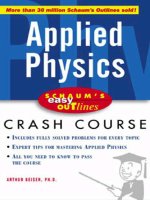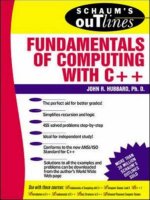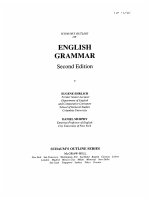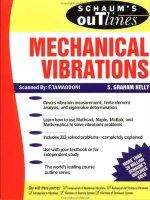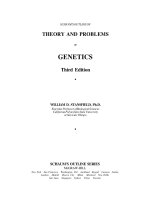SCHAUM''S OUTLINE of theory and problems of PROBABILITY
Bạn đang xem bản rút gọn của tài liệu. Xem và tải ngay bản đầy đủ của tài liệu tại đây (580.45 KB, 283 trang )
SCHAUM'S OUTLINE OF THEORY AM)
PROBLEMS OF PROBABILITY SEYMOUR
LIPSCHUTZ, Ph.D. Professor of Mathematics
Temple University SCHAUM'S OUTLINE
SERIES McGRAW-HILL New York San
Francisco Washington, D.C. Auckland Bogota
Caracas Lisbon London Madrid Mexico City
Milan Montreal New Delhi San Juan Singapore
Sydney Tokyo Toronto
Copyright © 1965 by The McGraw-Hill
Companies, Inc. All Rights Reserved. Printed in
the United States of America. No part of this
publication may be reproduced, stored in a
retrieval system, or transmitted, in any form or by
any means, electronic, mechanical, photocopying,
recording, or otherwise, without the prior written
permission of the publisher. ISBN 07-037982-3 31
32 33 34 35 36 BAW BAW 9098765432109
McGraw-Hill A Division ofTheMcGrmv-
HMCompanies
Preface Probability theory had its beginnings in the
early seventeenth century as a result of
investigations of various games of chance. Since
then many leading mathematicians and scientists
made contributions to the theory of probability.
However, despite its long and active history,
probability theory was not axiomatized until the
twenties and thirties of this century. This axiomatic
development, called modern probability theory,
was now able to make the concepts of probability
precise and place them on a firm mathematical
foundation. The importance of probability has
increased enormously in recent years. Today the
notions of probability and its twin subject statistics
appear in almost every discipline, e.g. physics,
chemistry, biology, medicine, psychology,
sociology, political science, education, economics,
business, operations research, and all fields of
engineering. This book is designed for an
introductory course in probability with high school
algebra as the only prerequisite. It can serve as a
text for such a course, or as a supplement to all
current comparable texts. The book should also
prove useful as a supplement to texts and courses
in statistics. Furthermore, as the book is complete
and self-contained it can easily be used for self-
study. The book begins with a chapter on sets and
their operations, and follows with a chapter on
permutations, combinations and other techniques of
counting. Next is a chapter on probability spaces
and then a chapter on conditional probability and
independence. The fifth and main chapter is on
random variables. Here we define expectation,
variance and standard deviation, and prove
Tchebycheff's inequality and the law of large
numbers. Although calculus is not a prerequisite,
both discrete and continuous random variables are
considered. We follow with a separate chapter on
the binomial, normal and Poisson distributions.
Here the central limit theorem is given in the
context of the normal approxi- approximation to
the binomial distribution. The seventh and last
chapter offers a thorough ele- elementary treatment
of Markov chains with applications. Each chapter
begins with clear statements of pertinent
definitions, principles and theorems together with
illustrative and other descriptive material. This is
followed by graded sets of solved and
supplementary problems. The solved problems
serve to illustrate and amplify the theory, bring into
sharp focus those fine points without which the
student continually feels himself on unsafe ground,
and provide the repetition of basic principles so
vital to effective learning. Proofs of most of the
theorems are included among the solved problems.
The supplementary problems serve as a complete
review of the material of each chapter. I wish to
thank Dr. Martin Silverstein for his invaluable
suggestions and critical review of the manuscript. I
also wish to express my appreciation to Daniel
Schaum and Nicola Monti for their excellent
cooperation. Seymour Lipschutz Temple
University
CONTENTS Page Chapter 1 SET THEORY 1
Introduction. Sets, elements. Set operations. Finite
and countable sets. Product sets. Classes of sets.
Chapter 2 TECHNIQUES OF COUNTING 16
Introduction. Fundamental principle of counting.
Factorial notation. Permutations. Permutations with
repetitions. Ordered samples. Binomial
coefficients and theorem. Combinations. Ordered
partitions. Tree diagrams. Chapter 3
INTRODUCTION TO PROBABILITY 38
Introduction. Sample space and events. Axioms of
probability. Finite probability- spaces. Finite
equiprobable spaces. Infinite sample spaces.
Chapter 4 CONDITIONAL PROBABILITY AND
INDEPENDENCE 54 Conditional probability.
Multiplication theorem for conditional probability.
Finite stochastic processes and tree diagrams.
Partitions and Bayes' theorem. Inde- Independence.
Independent or repeated trials. Chapter 5
RANDOM VARIABLES 74 Introduction.
Distribution and expectation of a finite random
variable. Variance and standard deviation. Joint
distribution. Independent random variables. Func-
Functions of a random variable. Discrete random
variables in general. Continuous random variables.
Cumulative distribution function. Tchebycheff's
inequality. Law of large numbers. Chapter 6
BINOMIAL, NORMAL AND POISSON
DISTRIBUTIONS 105 Binomial distribution.
Normal distribution. Normal approximation to the
binomial distribution. Central limit theorem.
Poisson distribution. Multinomial distribution.
Chapter 7 MARKOV CHAINS 126 Introduction.
Probability vectors, stochastic matrices. Regular
stochastic matrices. Fixed points and regular
stochastic matrices. Markov chains. Higher
transition probabilities. Stationary distribution of
regular Markov chains. Absorbing states. INDEX
152
Chapter 1 Set Theory INTRODUCTION This
chapter treats some of the elementary ideas and
concepts of set theory which are necessary for a
modern introduction to probability theory. SETS,
ELEMENTS Any well defined list or collection of
objects is called a set; the objects comprising the
set are called its elements or members. We write p
e A if p is an element in the set A If every element
of A also belongs to a set B, i.e. if p G A implies p
G B, then A is called a subset of В or is said to be
contained in B; this is denoted by ACB or В D A
Two sets are equal if each is contained in the
other; that is, A = В if and only if А с В and В с А
The negations of pGA, AcB and А—В are written
p€A, A<?B and A?*B respectively. We specify a
particular set by either listing its elements or by
stating properties which characterize the elements
of the set. For example, A = {1,3,5,7,9} means A
is the set consisting of the numbers 1, 3, 5, 7 and 9;
and В — {x : x is a prime number, x < 15} means
that В is the set of prime numbers less than 15.
Unless otherwise stated, all sets under
investigation are assumed to be subsets of some
fixed set called the universal set and denoted (in
this chapter) by U. We also use 0 to denote the
empty or null set, i.e. the set which contains no
elements; this set is regarded as a subset of every
other set. Thus for any set A, we have 0cA СU.
Example 1.1: The sets A and В above can also be
written as A = {x : x is an odd number, x < 10}
and В = {2, 3, б, 7, 11,13} Observe that 9 e Л but
9 Й B, and 11 G В but 11« A; whereas 3 ? Л and
36B, and 6«A and 6«B.
2 SET THEORY [CHAP. 1 Example 1.2: We use
the following special symbols: N = the set of
positive integers: 1, 2, 3, Z = the set of integers:
,-2,-1,0,1,2, R = the set of real numbers. Thus
we have NcZcR Example 1.3: Intervals on the real
line, defined below, appear very often in
mathematics. Here о and b are real numbers with о
< 6. Open interval from a to 6 = (a, 6) = {z : a < x
< 6} Closed interval from о to 6 = [a, 6] = {x : a ^
x - 6} Open-closed interval from о to 6 = (o, 6] =
{x : a < x — 6} Closed-open interval from о to 6 =
[o, 6) = {x : a — x < b} The open-closed and
closed-open intervals are also called half-open
intervals. Example 1.4: In human population
studies, the universal set consists of all the people
in the world. Example 1.5: Let С = {x : x1 = 4, x is
odd}. Then С = 0; that is, С is the empty set. The
following theorem applies. Theorem 1.1: Let А, В
and С be any sets. Then: (i) Ac A; (ii) if AcB and
BcA then A - B; and (iii) if AcB and BcC then
AcC. We emphasize that AcB does not exclude the
possibility that A = B. However, if AcB but A?*B,
then we say that A is a proper subset of B. (Some
authors use the symbol С for a subset and the
symbol С only for a proper subset.) SET
OPERATIONS Let A and В be arbitrary sets. The
union of A and B, denoted by A\JB, is the set of
elements which belong to A or to B. Аи В = {x: x
GA or x ЕВ} Here "or" is used in the sense of
and/or. The intersection of A and B, denoted by
AnB, is the set of elements which belong to both A
and B: АП В = {x: xGA and x G B) If AnB —
JZ>, that is, if A and В do not have any elements in
common, then A and В are said to be disjoint. The
difference of A and В or the relative complement
of В with respect to A, denoted by A \B, is the set
of elements which belong to A but not to B: A\B =
{x: xe A, x(?B} Observe that A\B and В are
disjoint, i.e. (A\B) П В = JZ>. The absolute
complement or, simply, complement of A, denoted
by Ac, is the set of elements which do not belong
to A: Ac = {x : x G U, x & A) That is, Ac is the
difference of the universal set U and A.
CHAP. 1] SET THEORY Example 1.6: The
following: diagrams, called Venn diagrams,
illustrate the above set operations. Here sets are
represented by simple plane areas and U, the
universal set, by the area in the entire rectangle. A.
-jB is •i \X$ is steutei. —-v. л ill в ^ A \\ '& m
&h»&$&. Л-" is яй«4<н?. Example 1.7: Let A =
{1,2,3,4} and В = {3,4,5,6} where U = {1, 2, 3,
}. Then AuB = A,2,3,4,5,6} AnB = {3,4} A\B =
{1, 2} Ac = {5,6,7, } Sets under the above
operations satisfy various laws or identities which
are listed in the table below (Table 1). In fact, we
state Theorem 1.2: Sets satisfy the laws in Table 1.
la. 2a. 3a. 4a. 5a. 6a. 7a. 8a. 9a. А и А - = A
(AuB)uC = A AuB = BvA LAWS OF THE
ALGEBRA Idempotent Associative u(BuC)
Commutative Distributive Au(BnC) =
(AuB)n(AuC) /4U0 = AuU AuAc (A'F = (AuB)c
= A = U = U A = Acn Laws lb. Laws 2b. Laws 3b.
Laws 4b. Identity Laws Complement De Morgan's
Be 5b. 6b. Laws 7b. 8b. Laws 9b. OF SETS AnA
= (AnB)n AnB = A С - An(BnC) BnA An(BuC) =
(AnB)u(AnC) AnU - A n 0 = AnAc = U° = 0,
(AnB)' A 0 = 0 0c= U = AcvBc Table 1
SET THEORY [CHAP. 1 Remark: Each of the
above laws follows from an analogous logical
law. For example, АП В = {x: xSA and x & B} =
{x : x S В and x S A} = В П A Here we use the
fact that the composite statement "p and q", written
рлд, is logically equivalent to the composite
statement "q and p", i.e. q л р. The relationship
between set inclusion and the above set operations
follows: Theorem 1.3: Each of the following
conditions is equivalent to AcB: (i) AnB = A (Hi)
B*CAC (v) BuAc - U (ii) AuB = В (iv) AnBc = p
FINITE AND COUNTABLE SETS Sets can be
finite or infinite. A set is finite if it is empty or if it
consists of exactly n elements where n is a positive
integer; otherwise it is infinite. Example 1.8:
Example 1.9: Example 1.10: Example 1J1: Let M
be the set of the days of the week; that is, M —
{Monday, Tuesday, Wednesday, Thursday, Friday,
Saturday, Sunday} Then M is finite. Let P — {x : x
is a river on the earth}. Although it may be difficult
to count the number of rivers on the earth, P is a
finite set. Let Y be the set of (positive) even
integers, i.e. Y — {2,4, 6, }. Then Y is an
infinite set. Let / be the unit interval of real
numbers, i.e. / = {x : 0 also an infinite set. x ^ 1}.
Then / is A set is countable if it is finite or if its
elements can be arranged in the form of a
sequence, in which case it is said to be countably
infinite; otherwise the set is uncountable. The set in
Example 1.10 is countably infinite, whereas it can
be shown that the set in Example 1.11 is
uncountable. PRODUCT SETS Let A and В be two
sets. The product set of A and B, denoted by A x
B, consists of all ordered pairs (a, b) where a & A
and b S S: Ax В = {(a, b) : a & A, b e B} The
product of a set with itself, say Ax A, is denoted
by A2. Example 1.12: The reader is familiar with
the cartesian plane К2 = К X R as shown below.
Here each point P represents an ordered pair (o, 6)
of real numbers, and vice versa. 2 -3 -2 -1 2 О з •
-1 -2 Example 1.13: Let A = {1,2,3} and В =
{a,b}. Then AxBr {(l,a), A,6), B,o), B,6), C,o),
C,6)}
CHAP. 1] SET THEORY The concept of product
set is extended to any finite number of sets in a
natural way. The product set of the sets Ai,A2, . .
.,Am, written Ai X A2 X • • • X Am, is the set of
all ordered m-tuples (aI( аг, ., dm) where сц G
Ai for each i. CLASSES OF SETS Frequently the
members of a set are sets themselves. For example,
each line in a set of lines is a set of points. To help
clarify these situations, we usually use the word
class or family for such a set. The words subclass
and subfamily have meanings analogous to subset.
Example 1.14: The members of the class {{2,3},
{2}, {5,6}} are the sets {2,3}, {2} and {5,6}.
Example 1.15: Consider any set A. The power set
of A, denoted by Ф(А), is the class of all sub-
subsets of A. In particular, if A = {a, b,e}, then
<P(A) = {A,{a,b},{a,e},{b,c},{a},{b},{c},0} In
general, if A is finite and has n elements, then
Ф(А) will have 2n elements. A partition of a set X
is a subdivision of X into nonempty subsets which
are disjoint and whose union is X, i.e. is a class of
nonempty subsets of X such that each a G X
belongs to a unique subset. The subsets in a
partition are called cells. Example 1.16: Consider
the following classes of subsets of X = {1,2,
.,8,9}: (i) [{1,3,5}, {2,6}, {4,8,9}] (ii) [{1,3,5},
{2,4,6,8}, {5,7,9}] (Hi) [{1,3,5}, {2,4,6,8},
{7,9}] Then (i) is not a partition of X since 7 ? X
but 7 does not belong to any of the cells.
Furthermore, (ii) is not a partition of X since 56^
and 5 belongs to both {1,3,5} and {5, 7, 9}. On the
other hand, (iii) is a partition of X since each
element of X belongs to exactly one cell. When we
speak of an indexed class of sets {Ai :iGl} or
simply {Ai}, we mean that there is a set At
assigned to each element i G I. The set / is called
the indexing set and the sets At are said to be
indexed by /. When the indexing set is the set N of
positive integers, the indexed class {Au A2, .} is
called a sequence of sets. By the union of these Air
denoted by Uie/ Ai (or simply UiAi), we mean the
set of elements each belonging to at least one of the
Ac, and by the intersection of the Ai, denoted by
CWei Ai (or simply PW Ai), we mean the set of
elements each belonging to every At. We also
write UjLi A, - AiUA2U • • • and ПГ=1 At =
АХГ\А2П ¦ ¦ ¦ for the union and intersection,
respectively, of a sequence of sets. Definition: A
nonempty class cA of subsets of U is called an
algebra (o-algebra) of sets if: (i) the complement
of any set in cA belongs to cA; and (ii) the union of
any finite (countable) number of sets in c/t belongs
to cA; that is, if cA is closed under complements
and finite (countable) unions. It is simple to show
(Problem 1.30) that an algebra (a-algebra) of sets
contains U and ф and is also closed under finite
(countable) intersections.
6 SET THEORY [CHAP. 1 Solved Problems
SETS, ELEMENTS, SUBSETS 1.1. Let A = {x:3x
= 6}. Does A = 21 A is the set which consists of
the single element 2, that is, A = {2}. The number
2 belongs to A; it does not equal A. There is a
basic difference between an element p and the
singleton set {p}. 1.2. Which of these sets are
equal: {r, s, t}, {t, s, r), {s,r,t}, {t,r, s}? They are
all equal. Order does not change a set. 1.3.
Determine whether or not each set is the null set:
(i) X = {ж:х2 = 9, 2x = 4}, (ii) Y = {x: x Ф x},
(iii) Z = {x:x + 8 = 8}. (i) There is no number
which satisfies both x2 = 9 and 2x = 4; hence X is
empty, i.e. X = 0. (ii) We interpret "=" to mean "is
identical with" and so Y is also empty. In fact,
some texts define the empty set as follows: 0 = {x:
хФ x). (iii) The number zero satisfies x + 8 = 8;
hence Z = {0}. Accordingly, Z is not the empty set
since it contains 0. That is, Z Ф 0. 1.4. Prove that
A = {2,3,4,5} is not a subset of В = {х:х is even}.
It is necessary to show that at least one element in
A does not belong to B. Now 3 ? A and, since В
consists of even numbers, 3??; hence A is not a
subset of B. 15. Let V={d), W={c,d), X={a,b,c},
Y = {a,b} and Z={a,b,d). Determine whether each
statement is true or false: (i) YCX, (ii) W Ф Z,
(iii) ZdV, (iv) V С X, (v) X = W, (vi) W С У. (i)
Since each element in Y is a member of X, Y С X
is true. (ii) Now a G Z but a « W; hence W Ф Z is
true. (iii) The only element in V is d and it also
belongs to Z; hence 2DVis true. (iv) V is not a
subset of X since d G V but d& X; hence FcXis
false. (v) Now aSXbuta&W; hence X = W is false.
(vi) W is not a subset of Y since с G PF but с g F;
hence W с F is false. 1.6. Prove: If A is a subset of
the empty set 0, then A = 0. The null set 0 is a
subset of every set; in particular, 0 С A. But, by
hypothesis, А С 0; hence A = 0. 1.7. Prove
Theorem l.l(iii): If А С S and В с G, then А с С.
We must show that each element in A also belongs
to C. Let x G A. Now А С В implies x G В. But В
С С; hence x G C. We have shown that x G A
implies x G C, that is, that А С С 1.8. Which of the
following sets are finite? (i) The months of the
year. (iv) The set Q of rational numbers. (ii)
{1,2,3, .,99,100}. (v) The set R of real numbers.
(iii) The number of people living on the earth. The
first three sets are finite; the last two are infinite.
(It can be shown that Q is countable but R is
uncountable.)
CHAP. 1] SET THEORY 7 1.9. Consider the
following sets of figures in the Euclidean plane: A
= {x : x is a quadrilateral} С = {x : x is a
rhombus} В = {x : x is a rectangle} D = {x : x is a
square} Determine which sets are proper subsets
of any of the others. Since a square has 4 right
angles it is a rectangle, since it has 4 equal sides it
is a rhombus, and since it has 4 sides it is a
quadrilateral. Thus D с A, D с В and D с С that is,
D is a subset of the other three. Also, since there
are examples of rectangles, rhombuses and
quadrilaterals which are not squares, D is a proper
subset of the other three. In a similar manner we
see that В is a proper subset of A and С is a proper
subset of A. There are no other relations among the
sets. 1.10. Determine which of the following sets
are equal: 0, {0}, {0}. Each is different from the
other. The set {0} contains one element, the
number zero. The set 0 contains no elements; it is
the empty set. The set {0} also contains one
element, the null set. SET OPERATIONS 1.11. Let
U= {1,2, ,8,9}, A = {1,2,3,4}, B = {2,4,6,8} and
С ={3,4,5,6}. Find: (i) Ac, (ii) AnC, (iii) {AnC)c,
(iv) А и В, (v) B\C. (i) Ac consists of the elements
in U that are not in A; hence Ac — {6,6,7,8,9}. (ii)
AnC consists of the elements in both A and C;
hence AnC = {3,4}. (iii) (AC\C)C consists of the
elements in V that are not in AnC. Now by (ii),
AnC = {3,4} and so (AnC)c= {1,2,6,6,7,8,9}. (iv)
AuB consists of the elements in Л or В (or both):
hence AUJB = {1,2,3,4,6,8}. (v) B\C consists of
the elements in В which are not in C; hence B\C =
{2,8}. 1.12. Let U = {a,b,c,d,e}, A = {a,b,d) and B
= {b,d,e). Find: (i) Аи В (iii) Bc (v) AcnB (vii)
AcnBc (ix) (AC\B)C (ii) BnA (iv) B\A (vi) AuBc
(viii) BC\AC (x) (AuB)c (i) The union of A and В
consists of the elements in A or in В (or both);
hence AuB = {a,b,d,e}. (ii) The intersection of A
and В consists of those elements which belong to
both A and B; hence Ar\B = {b,d}. (iii) The
complement of В consists of the letters in U but not
in B; hence Bc = {a, e}. (iv) The difference B\A
consists of the elements of В which do not belong
to A; hence B\A = {e>. (v) Ac = {e,e} and В =
{b,d,e}; then A<=nB = {e}. (vi) A = {a, b,d) and
Bc = {a,e}; then AUBC = {a, b,e,d}. (vii) and
(viii). Ac = {e, e) and Bc = {a, e}; then АСГ\ВС =
{c} and BC\AC = {a} (ix) Prom (ii), AnB = {b,d};
hence (А Г\В)С = {a, e, e). (x) From(i), AuB =
{a,b,d,e}; hence {AuB)<= = {e}.
SET THEORY [CHAP. 1 1.13. In the Venn
diagram below, shade: (i) Bc, (ii) {AuB)c, (iii)
(B\A)C, (iv) AcnBc. &Э (i) Bc consists of the
elements which do not belong to B; hence shade
the area outside В as follows: Bc is shaded. (ii)
First shade AuB; then (A UB)C is the area outside
AuB: Аи В is shaded. (A UB)C is shaded. (iii)
First shade B\A, the area in В which does not lie in
A; then (B\A)C is the area outside B\A: I A B\A M
4 is shaded. (В\Л)= is shaded. (iv) First shade Ac,
the area outside of A, with strokes slanting upward
to the right (////), and then shade Bc with strokes
slanting downward to the right (\^\); then AcnBc is
the cross-hatched area: Ac and Bc are shaded.
AcnBc is shaded. Observe that (A U By — Ac n
JBC, as exacted by De Morgan's law.
CHAP. 1] SET THEORY 1.14. Prove: B\A =
Bf\Ae. Thus the set operation of difference can be
written in terms of the operations of intersection
and complementation. B\A = {x : x G B, x « A) =
{x : x G B, x G A<=) - ВC\ A<= 1.15. Prove: For
any sets A and В, АГ\В cAcAUB. Let x G A C\B;
then x G A and x G B. In particular, i?/l. Since x G
A C\B implies x € A, AnB с A. Furthermore if x G
A, then a: G Л or a: G B, i.e. a; G Л и JR. Hence
Л С Л UJR. In other words, AnB с А с Aи JR.
1.16. Prove Theorem 1.3(i): A cB if and only if
АГ\В = А. Suppose Л С JR. Let x G Л; then by
hypothesis, a: G B. Hence xG A and a: e B, i.e. ж
G AnB. Accordingly, Ac An В. On the other hand,
it is always true (Problem 1.16) that AnB С Л.
Thus AnB = A. Now suppose that AnB = A. Then
in particular, Л сАпв. But it is always true that
AnB С B. Thus Л cAnBcB and so, by Theorem
1.1, А с В. PRODUCT SETS 1.17. Let M = {Tom,
Marc, Erik} and W = {Audrey, Betty}. Find MxW.
MX.W consists of all ordered pairs (a, b) where a
G M and Ь G W. Hence U X W = {(Tom, Audrey),
(Tom, Betty), (Marc, Audrey), (Marc, Betty),
(Erik, Audrey), (Erik, Betty)} 1.18. Let A =
{1,2,3}, В ={2,4} and С ={3,4,5}. FindAxBxC. A
convenient method of finding A X В X С is through
the so-called "tree diagram" shown below: 3 4 6 3
4 6 3 4 5 3 4 5 3 4 6 3 4 5 A. A, A. A, A, A, B, B,
B, B, B, B, C, C, C, C, C, C, 2,3) 2,4) 2,6) 4,3)
4,4) 4,6) 2,3) 2,4) 2,6) 4,3) 4,4) 4,6) 2,3) 2,4) 2,6)
4,3) 4,4) 4,6) The "tree" is constructed from the
left to the right. Л X В X С consists of the ordered
triples listed to the right of the "tree". 1.19. Let А=
{а,Ъ}, В ={2,3} and С ={3,4}. Find: (i) A x
(BUC), (ii) (A x B) U (A x C), (iii) A x (BnC),
(iv) (A x B) n (A x Q. (i) First compute В и С =
{2, 3,4}. Then AX(BUC) = {(a,2), (a, 3), (a,4),
(b,2), (b,3), (b,4)}
10 SET THEORY [CHAP. 1 (ii) First find A X В
and A X C: AX В = {(a, 2), (o,3), (b,2), (b,3)}
AXC = {(o,3), (a, 4), F,3), F, 4)} Then compute
the union of the two sets: (A X B) U (A X C) =
{(a, 2), (a, 3), F, 2), F, 3), (a, 4), F,4)} Observe
from (i) and (ii) that Ax(BuC) = (AxB)u(AxC) (iii)
First compute JRnC={3}. Then Ax(BnC) = {(a,3),
(b,3)} (iv) Now Ax В and A X С were computed
above. The intersection of A X В and A X С
consists of those ordered pairs which belong to
both sets: (A X B) n (A X С) = {(а, 3), F, 3)}
Observe from (iii) and (iv) that A x (JBnC) = (A x
JB) n (A x О 1.20. Prove: Ax(BnC) = (АхВ)П{Ах
С). AX(BnC) = {(x,y) : xe A, yGBnC) = {(x,y):
xGA, yGB, yGC] = {(x,y): (x,y)GAxB,
(x,y)GAxC) = (A x B) n (A x C) 1.21. Let S =
{a,b}, W = {1,2,3,4,5,6} and У ={3,5,7,9}. Find
(S x W) П (S x V). The product set (S X W) n (S X
У) can be found by first computing SxW and SxV,
and then computing the intersection of these sets.
On the other hand, by the preceding problem,
(SxW)n(SxV)=Sx(WnV). Now H'nV = {3,5}, and
so (SxW)n(SxV) = Sx(WnV) = {(o,3),(o,5), (Ь,8),
(Ь,Б)} 1.22. Prove: Let AcB and CcD; then
DxC)c(BxD). Let (x,y) be any arbitrary element in
A X C; then x e A and у & C. By hypothesis, AcjB
and CcD; hence ж e jR and у € D. Accordingly
(x,j/) belongs to В X D. We have shown that (ж,
j/) e A X С implies (x, y) G В x D; hence (A X С)
С (JB x D). CLASSES OF SETS 1.23. Consider
the class A = {{2,3}, {4,5}, {6}}. Which
statements are incorrect and why? (i) {4,5}CA,
(ii) {4,5} ЕЛ, (iii) {{4,5}}CA. The members of A
are the sets {2,3}, {4,6} and {6}. Therefore (ii) is
correct but (i) is an incorrect statement. Moreover,
(iii) is also a correct statement since the set
consisting of the single element {4, 5} is a
subclass of A. 1.24. Find the power set <P(S) of
the set S = {1,2,3}. The power set <P(S) of S is
the class of all subsets of S; these are {1, 2,3}, {1,
2}, {1, 3}, {2, 3}, {1}, {2}, {3} and the empty set
0. Hence <P(S) = {S, {1,3}, {2,3}, {1,2}, {1},
{2}, {3}, 0} Note that there are 23 = 8 subsets of
S.
CHAP. 1] SET THEORY Ц 1.25. Let X =
{a,b,c,d,e,f,g}, and let: (i) Ai = {a,c,e}, A2 = {b},
A3 = {d,g}; (ii) B, = {a,e,g}, B2 = {c,d}, B3 =
{b,e,f}; (iii) Ci = [a,b,e,g}, C2= {c}, Cz= [d,f);
(iv) Di = [a,b,c,d,e,f,g}. Which of {Ai,A2,As},
{ВьВ2,Бз}, {Ci,C2,C3}, f?>i} are partitions of XI
(i) {A,, A2,A3) is not a partition of X since / G X
but / does not belong to either Au A2, or A3. (ii)
{Bi, B2, B3) is not a partition of X since e € X
belongs to both B1 and B3. (iii) {Ci, C2, C3} is a
partition of X since each element in X belongs to
exactly one cell, i.e. X = C[UC2UC3 and the sets
are pairwise disjoint. (iv) {E^} is a partition of X.
1.26. Find all the partitions of X - {a,b,c,d}. Note
first that each partition of X contains either 1, 2, 3,
or 4 distinct sets. The partitions are as follows: A)
[{a,b,c,d}} B) [{a}, {b,c,d}], [{b), {a,e,d}], [{c},
{a, b,d}}, [{d}, {a, b, c}}, [{a,b}, {c,d}], [{a,e),
{b,d}}, [{a,d), {b,c}} C) [{a}, {b}, {c,d}], [{a},
{c}, {b,d}], [{a}, {d}, {b,c}], [{b}, {c}, {a,d}],
[{b}, {d}, {a,e}], [{e), {d}, {a, b}} D) [{a}, {6},
{c}, {d}] There are fifteen different partitions of
X. 1.27. Let N be the set of positive integers and,
for each n G N, let An = {x : x is a multiple of n] =
{n, 2n, 3n, . . .} Find (i) А3ПА5, (ii) А*г\Ац, (iii)
UtepAi, where P is the set of prime numbers, 2, 3,
5, 7, 11, (i) Those numbers which are multiples
of both 3 and 5 are the multiples of 15; hence
A3nAs — A15. (ii) The multiples of 12 and no
other numbers belong to both A4 and Ae; hence
44nA6 = A12. (iii) Every positive integer except 1
is a multiple of at least one prime number; hence
uj6P Aj = {2,3,4, } = N\{1} 1.28. Prove: Let
{At: i e /} be an indexed class of sets and let i0 S
/. Then njeJ Ai С AiQ С Uiei Ai Let а;еп(е/А(;
then x G A{ for every i€/. In particular, x e A^.
Hence rue j А( С Aj(). Now let у e Ai(). Since
iBe/, у G LUejAj. Hence Aj() с uie/ A{. 1.29.
Prove (DeMorgan's law): For any indexed class
{Ai iGl}, (U<Ai)c = n{Ai. (и{А()с -¦ {ас:
aceUjAj} = {ас: ас Й A{ for every г} = {ас : ас €
